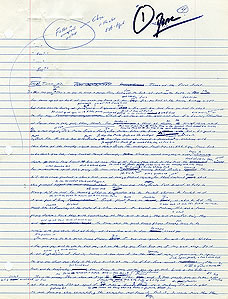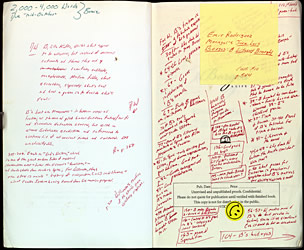Archive for the ‘language’ Tag
Lara Logan story botched by LA Weekly
On February 15th the LA Weekly published a post by Simone Wilson under the headline “Lara Logan, CBS Reporter and War Zone ‘It Girl,’ Raped Repeatedly Amid Egypt Celebration.” The opening paragraph stated that Logan had been “brutally and repeatedly raped” — with that phrase emphasized in bold type.
The LA Weekly apparently got the story wrong. Logan had suffered a horrifying sexual assault while working in Cairo’s Tahrir Square, disturbing details of which came to light in subsequent media coverage. But according to reporting from three different news outlets — The Wall Street Journal, the New York Post, and IOL News of South Africa (Logan’s native country) — Logan was not raped. Those articles were cited in a MediaBugs error report posted last week by Tracy Clark-Flory, a journalist who covers women’s issues. (Disclosure: Clark-Flory is a friend and former colleague of mine at Salon.) Since the report was posted, MediaBugs sent three emails to LA Weekly editors seeking a response. We’ve received none.
It’s understandable how a news organization might have made this kind of mistake; while many initial reports about Logan’s attack adhered to a statement from CBS News describing “a brutal and sustained sexual assault and beating,” LA Weekly wasn’t the only outlet to make the leap to “rape.” (See Jen Phillips’ post on MotherJones.com for more on this.)
Still, it’s troubling that more than three weeks later the LA Weekly has not posted a correction on its piece, or explained why it believes no correction is warranted. To say that accuracy is important to a news organization’s credibility is stating the obvious — but it seems particularly crucial when public understanding is distorted around a story as emotionally and politically fraught as Logan’s.
Here’s one small anecdote showing why. Last weekend I described the issue to a friend who is well-read on current events. He said that he’d seen the LA Weekly piece, among others. When I told him that Logan apparently had not been raped, he was surprised — he’d understood that to be a central fact of the story.
The LA Weekly’s silence on the matter could in part be due to the withering criticism it came under for Wilson’s piece, which ran with a curvaceous photo of Logan and used various sexualized descriptions of her, including “firecracker” and “gutsy stunner.” Newsrooms tend to circle the wagons when under attack.
That uproar, ultimately, was a matter of editorial judgment and (brutally bad) taste, one that LA Weekly editors may or may not choose to address at some point. (Wilson did so, to some degree, in an update to her post on Feb. 16.)
But this issue is more straightforward. By not addressing the apparent factual mistakes brought to its attention, the LA Weekly not only damages its reputation but also does a disservice to Logan’s story, which has cast a powerful light on a previously underreported problem faced by female journalists. The uncorrected errors take a piece that already comes across as insensitive and make it seem irresponsible, too.
[Note: This post first appeared on PBS.org’s MediaShift blog.]
UPDATED: It seemed worthwhile to include this subsequent exchange I had with an anonymous reader in the PBS MediaShift comments thread:
Anonymous: “I agree with you for the most part, however… no named source has yet contradicted their account. It could be that Lara was raped. We still don’t know.”
My reply: “True, the details of what happened still aren’t entirely clear. But since all the evidence we do have points to Logan not being raped, reasonable readers have a right to raise questions — and they deserve an answer from the LA Weekly. Perhaps the Weekly knows something it hasn’t shared, though the piece appeared to include no original reporting and that seems unlikely. Regardless, if the public raises legitimate questions the onus is on the newsroom to support — or correct — its account.”
UPDATED, 3/15/11: LA weekly has since posted a correction notice stating that it “erroneously interpreted CBS’ report of what happened to Logan on February 11, 2011.”
As of this update the original article’s headline and repeated references to “rape” in the text remain unchanged.
For additional details, see the updated mediabug.
This is Yahoo News on speed: too fast for a correction notice
Recently the Spanish-language site of Yahoo News reported that NASA had contracted with three companies to develop some truly incredible commercial aircraft. The future planes, Yahoo reported, could be available by 2025 and fly at 85 percent of the speed of light. Just imagine: You’d be able to jump aboard one of these suckers and zing from Vancouver to Capetown in, oh, about a fifteenth of a second. Now that’s newsworthy!
 And perhaps it might even be possible — but it’s not true. As a MediaBugs user reported, NASA is in fact aiming for these future aircraft to reach 85 percent of the speed of sound. (Impressive in its own right, but nothing remotely approaching the speed of light.) Apparently somebody at Yahoo Noticias en Espanol had mistranslated the NASA press release from which the story was mostly drawn.
And perhaps it might even be possible — but it’s not true. As a MediaBugs user reported, NASA is in fact aiming for these future aircraft to reach 85 percent of the speed of sound. (Impressive in its own right, but nothing remotely approaching the speed of light.) Apparently somebody at Yahoo Noticias en Espanol had mistranslated the NASA press release from which the story was mostly drawn.
Even seemingly small errors in the news — in this case a single mistranslated word — can matter, and they should be corrected with care. The Yahoo story was fixed a day or two after the mediabug was posted — a positive outcome — although without any notice to the public that it was changed. [*See update below.] We don’t actually know how the error came to Yahoo’s attention; I couldn’t get any meaningful response from the company when I tried to let them know about it.
Which is quite difficult to do. Yahoo News has no corrections info or content of any kind, nor any real channel for contacting its editors or producers. (When I tried the “News Help Form,” found via a barely noticeable link in the page footer, I received a comically unhelpful “Escalation Notice,” followed a day later by an email from a customer service rep promising to “send this information to our editors if necessary.” By that point the article had already been fixed.)
As we revealed in an in-depth MediaBugs study published in November, many legacy print-news companies are still stumbling big-time when it comes to error reports and corrections online. Yahoo News, of course, can’t even plead about transitioning to digital in an era of dwindling resources; it is part of a pioneering technology company native to the two-way medium of the Web. So why isn’t it doing a better job with this stuff?
Part of the answer may be that Yahoo News primarily is an aggregation site, filled with wire service stories and links to reporting from other news organizations. But in July 2010 Yahoo launched The Upshot, a news blog with original content produced by a small handful of established reporters and editors. Yahoo News already commanded huge traffic, but now the company apparently was making a bid for greater news-media relevance (and, presumably, even more traffic). Its Twitter feed, followed by roughly 62,000 people, says that its “Tweets are hand-picked by the Y! News Team and 100% RSS feed free!” In other words, there are real people behind the curtain here.
Still, good luck reaching them. In addition to trying the “help” form and contact via Twitter, I emailed an Upshot editor, Chris Lehmann, to see about reporting the “speed of light” error. He responded quickly and cordially, telling me that he had no idea whom to contact about it, particularly since the error was on the Spanish-language site. I commented that correcting a substantive error without any notice to the public is bad form. (Yahoo News has company in this practice: The New York Times and Reuters recently were caught doing this too.) “On the U.S. news blogs,” Lehmann said with regard to substantive fixes, “we always append an update to note when we’ve corrected the text.”
The Upshot also stands out from the Yahoo News mother ship by providing on its main page a visible list of editorial staff and their contact info. “Keep us honest,” editor Andrew Golis wrote last July. “Email us, comment on our posts, let us know when we’ve made a mistake. When we agree with you, we’ll be fast and transparent about fixing it, apologizing and explaining.”
The rest of the Yahoo News operation should get onboard with that agenda if it wants the public to trust in its content, already an uphill battle for the news media in general.
 Here’s a suggestion to the managers of Yahoo News for a good start: Join the Report an Error Alliance. Put that snazzy little red-and-black button on every news page. When it bleeps with reader feedback, have somebody around to respond in reasonably short order (light speed won’t be necessary!) and publish the results in a transparent, user-friendly way.
Here’s a suggestion to the managers of Yahoo News for a good start: Join the Report an Error Alliance. Put that snazzy little red-and-black button on every news page. When it bleeps with reader feedback, have somebody around to respond in reasonably short order (light speed won’t be necessary!) and publish the results in a transparent, user-friendly way.
UPDATE, 11:30 a.m. PT: Things have since accelerated farther away from clarity: When I returned to the Yahoo News story page today to check for an update I discovered that the text has changed back to the erroneous version first published. Whereas the segments in question had been changed from “la velocidad de la luz” to “la velocidad del sonido” they are now back to the former.
My suspicion is that while the first change was in all likelihood made by a person, the reversion to the error is probably due to a system glitch whereby that fix was overwritten. Of course, this points back not so neatly to the crux here — we have no effective way to inform Yahoo News about the problem, let alone get a clear explanation from them.
[Ed. note: This post also appeared today on the MediaBugs blog.]
Bonsai music, the sound of sadness, and a killing via Twitter
Gentle readers: It’s been another busy month, including a trip to MIT for the Future of News and Civic Media Conference, where we showcased the first phase of MediaBugs and hung out with a bunch of interesting folks working on some intriguing cutting-edge projects.
 In lieu of posting here since an early June dive into the Gulf calamity, I offer a third experimental installment of self-aggregated micro-blogging, which has proven a considerably easier way to riff while on the run. (Also see installments one and two.) Nicholas Carr may believe web links are rotting our brains, in which case I’ve already spoiled your screen, but I’m more with Steven Johnson on the “greatest serendipity engine in the history of culture” thing. Happy browsing.
In lieu of posting here since an early June dive into the Gulf calamity, I offer a third experimental installment of self-aggregated micro-blogging, which has proven a considerably easier way to riff while on the run. (Also see installments one and two.) Nicholas Carr may believe web links are rotting our brains, in which case I’ve already spoiled your screen, but I’m more with Steven Johnson on the “greatest serendipity engine in the history of culture” thing. Happy browsing.
*
Rolling Stone is “back on a roll.” And apparently not because of that booty-licious Lady Gaga cover. http://nyti.ms/dssVSY about 6 hour ago via web
#BP’s audacious new plan to drill, baby, drill off Alaska: http://nyti.ms/cQ6RVn Thu Jun 24 17:37:58 2010
embattled and/or bespectacled journos reportedly should not stir outcry about senseless murders in the leafy suburbs: http://bit.ly/9RBzFK Thu Jun 24 14:42:41 2010
A serious bonsai tree jam: http://j.mp/dubR2D Wed Jun 23 18:59:19 2010
ancient big weather and what may be the world’s largest dinosaur graveyard: http://bit.ly/bP2wZd Wed Jun 23 15:38:14 2010
The same intervals that express sadness in music also found in speech: http://ow.ly/21KDz Tue Jun 22 11:05:53 2010
Utah attorney general live tweets execution by firing squad: http://yhoo.it/bv3ol8 Fri Jun 18 12:20:12 2010
in Iraq, “the biggest campaign of dog execution ever.” And KBR is involved. http://bit.ly/azxcYc Fri Jun 18 08:37:46 2010
CNN “expert” says that Obama’s Gulf speech used, uh, too many words, or words w/too many letters, or… somethin’ http://bit.ly/cUfOZg #dumbcoverage Thu Jun 17 12:01:11 2010
what’s the carbon footprint of that thing you’re about to buy? Very cool project, Sourcemap, from CFCM at MIT http://bit.ly/zA1a4 #knc10 Wed Jun 16 15:36:58 2010
Tom Waits’ personal playlist: http://bit.ly/bMlZAp Wed Jun 16 15:29:46 2010
now that’s politics with brains! accusing your opponent of “waterboarding” the economy: http://politi.co/cTGh0a #WTF Mon Jun 14 12:49:57 2010
“We must save the oceans if we want to save mankind.” -Jacques Cousteau (born 100 yrs ago this Friday) #oilspill Wed Jun 9 14:42:11 2010
AP dateline: UNDER THE MURKY DEPTHS OF THE GULF OF MEXICO (reporter into “thickest patch of red oil I’ve ever seen”) http://yhoo.it/cfQfaH Wed Jun 9 09:38:34 2010
the catastrophe of oil-soaked birds, explained: http://bit.ly/doM9gd #BP #oilspill #alt-energy-now Tue Jun 8 11:32:34 2010
Twitter fix
Dear Loyal Readers:
You’ve probably noticed a slower pace in this space recently; I’ve been immersed in a couple of projects, including getting MediaBugs off the ground. But if you’re on Twitter, you know how easy it is these days to keep the conversation going, at least 140 characters at a time, and indeed I’ve found it to be the best channel for sharing thoughts and links of interest in the interim. (I plan to return to more active blogging again soon.) Several times daily (on most days) you can follow my finger on the digital pulse here.
 If you’re a Twitter user you also know how easy it is to miss a million things in the collective news stream you’ve let flow; to try to take in everything would be like drinking from a fire hose all day long. You may not even realize your own effect on the flow, and it can be illuminating to take a look back over your collective contribution. The sum of the parts can almost start to take on a flarf-like quality. Here are some recent bits from my adventures in micro-blogging, with lots of links for your browsing delight and/or distraction…
If you’re a Twitter user you also know how easy it is to miss a million things in the collective news stream you’ve let flow; to try to take in everything would be like drinking from a fire hose all day long. You may not even realize your own effect on the flow, and it can be illuminating to take a look back over your collective contribution. The sum of the parts can almost start to take on a flarf-like quality. Here are some recent bits from my adventures in micro-blogging, with lots of links for your browsing delight and/or distraction…
***
well, there goes another “entire copy desk” at a major newspaper http://bit.ly/9wj5Sn about 3 hours ago
“The daily activity most injurious to happiness is commuting” http://nyti.ms/boSnGB about 4 hours ago
Seder at the White House sounds pretty cool http://nyti.ms/aKnvmv about 5 hours ago
Jesus was way hungry http://nyti.ms/diC4Hq 12:23 PM Mar 29th
war gaming Iran. Conclusion? Not a great idea. http://nyti.ms/a2cqsq 11:33 AM Mar 29th
vivid Jim Marshall photos: Jimi http://bit.ly/dD5ko3 … and Johnny http://bit.ly/b1Hcl0 10:09 PM Mar 25th
the dark side of nanotech? http://bit.ly/cHGvja 5:43 PM Mar 24th
global warming upshot: ocean swallows disputed island in Bay of Bengal http://bit.ly/chJyUr 4:21 PM Mar 24th
uh, not just anyone can hope to dodge home foreclosure with the help of PETA http://bit.ly/bhIXWU 4:13 PM Mar 24th
some say blogging is dead, respected bloggers included. @scottros says not so fast http://to.pbs.org/a94Cax 4:03 PM Mar 24th
you are watching your TV and surfing the Web at the same time, aren’t you. http://j.mp/aetKD7 11:09 AM Mar 22nd
finally got up the nerve to watch “The Cove” last night. Extraordinary film. Check it out, spread the word. http://www.takepart.com/thecove/ 10:02 AM Mar 22nd
7 years of war in Iraq today. Consider the names & faces of the dead: http://nyti.ms/c8p3tf 9:18 AM Mar 19th
Ailes to Fox staff unhappy w/insane Glenn Beck: “We prefer people in the tent not dumping on other people in the tent” http://bit.ly/9pzCFR 11:22 AM Mar 18th
RIP Alex Chilton http://bit.ly/9s6SGe 12:42 AM Mar 18th
from the dystopian California files: more than 23,000 school teachers get pink slipped http://dlvr.it/DRdg 6:00 PM Mar 15th
think twice before doing crimes at your keyboard http://bit.ly/bdIRVe 12:55 PM Mar 15th
French bread was spiked with LSD in CIA experiment: http://bit.ly/akIZn6 8:48 AM Mar 12th
Congrats to Haida artist Robert Davidson for receiving the 2010 Governor General’s Awards in Visual and Media Arts http://bit.ly/dgXJVv 1:43 PM Mar 11th
the ultimate crime deterrent: San Quentin reviewed on Yelp http://tcrn.ch/dgDp8N (Indeed, the food apparently is “horrible”) 1:49 PM Feb 23rd
how many Tweets per day now? Oh, about 50 million. That is, 600 *every second*… (via @robinsloan) http://is.gd/8X8NI 12:56 PM Feb 22nd
***
Go here to drink more from the fire hose!
Into the mind of David Foster Wallace
A few years back when I was working on craft at USF, I found inspiration in the idea that writers work in perpetual dialogue with their fellow scribes — not just immediate peers, but also those across geography and time. The books whose authors spoke to you — the ones that you kept returning to and sat with and spoke back to — granted insight and spurred productivity as much as any workshopping of manuscripts ever did. That kind of literary communion was something David Foster Wallace knew well. The archive at UT has already put some of his on display, with this look inside some of DFW’s intricately annotated books. (Click on the images at the above link to zoom in.) Inside his copy of The Puttermesser Papers, for example, you can see his studied list of Cynthia Ozick’s diction, from “telluric” to “pullulating” to “fructuous.” Notes scrawled inside the cover of Don Delillo’s Players reveal traces of his thinking about The Pale King, a novel he had yet to complete at his death: “Guy hired as lawyer for IRS. Sent to Peoria, but no one ever complains or contests audits in Peoria.”
Even just visually, as his copy of “Borges: A Life” shows, it’s easy to see that DFW’s immersions went deep:
There’s also a poignancy to seeing these snatches of handwritten script, an intimate reminder of his tragic, early exit. May the scholars soon get to work at UT and take us even deeper into the mind and methods of one of the great writers of his generation.
UPDATE: Lots more on the contents of the DFW archive from the New Yorker’s Book Bench blog.
Helping fix the error-filled news
I’m very happy to announce my involvement in a new startup called MediaBugs, where I’ll be serving as associate director and community manager. I’m joining with project founder and director Scott Rosenberg (with whom I had the great pleasure of working during my years at Salon) for what we anticipate will be an exciting and, hopefully, groundbreaking effort. We are now in the process of building out our Web site, with plans to start rolling out the service in early 2010. The two-year project is funded by the Knight Foundation, and will focus on all manner of media in the San Francisco Bay Area.
In a nutshell, MediaBugs will provide a neutral, civil forum where the public can report errors they encounter in the news and try to get them fixed. The idea is to leverage the open-source power of the Web to achieve greater transparency and dialogue among media institutions and the public, and thereby improve the quality of the news.

We see it as a winning proposition for everyone involved — a way to begin rebuilding public confidence in the media, while offering our fellow journalists a compelling tool they can use to enhance their work in this ever-dynamic digital age.
Why focus on fixing errors in the news? For one, public trust in the media wallows at a historic low. As Scott explained in a recent blog post, there are several reasons for this — perhaps chief among them that the news is riddled with mistakes, and an extraordinary percentage of them go uncorrected.
There are different kinds of errors, but even the seemingly trivial ones matter. (And there are a great many of them, as detailed at the above links, a status quo surely not helped by today’s painful editorial cutbacks.) If the local paper or news site regularly publishes misspelled names or inaccurate dates, how can its readers trust that it got the really important stuff right?
The problem afflicts small and big players alike. This week, the Washington Post’s public editor Andrew Alexander was compelled to explain why a respected sports columnist at the paper whiffed big time with some of his World Series coverage.
“By my count,” Alexander wrote, “the column contained at least 20 typos, grammatical errors or misspellings.”
Curiously, the Post treated a cleaned-up version of the piece, posted online after the shoddy print version went out, as separate. That’s a questionable distinction, with the lines between blog posts, columns and articles rapidly blurring these days, and with digital and print newsroom operations fast merging. There is still no correction appended to the online version of the World Series column, so unless you’d already caught wind of Alexander’s write-up you wouldn’t even know about the flurry of mistakes that appeared in print. Doesn’t seem like the best way to win over skeptical readers.
For more details on how MediaBugs will work, visit our site here, and stay tuned for more soon.
The world according to Flarf
After I posted about the strange poetry of search yesterday, I was happy to receive an email from my friend Alex Davis, a poet and former classmate in the MFA program at University of San Francisco, with some clarification about the realm into which I had stumbled. Turns out there is a whole literary “movement” built on search engine detritus. (Of course there is.) It’s known as Flarf. It dates all the way back to the beginning of the millennium.
Apparently the method of the flarfists “was to mine the Internet with odd search terms and then distill the results into often hilarious and sometimes disturbing poems, plays, and other texts.” This was hardly a new artistic impulse. But its digital extension — a kind of Cut-up 2.0, if you will — certainly seemed to capture the tenor of these times. According to flarf’s Wikipedia entry, “Early or ‘old-school’ flarf is marked by a certain distinctive tonal ‘dialect’: it is often peppered with phrases like ‘aw YEEEAHH,’ intentional typos, mildly offensive language (e.g., childish references to bodily functions), oblique political ‘statements,’ and incongruous animal imagery.”
Indeed. Or, as one early practitioner put it, the dominant tenor of flarf could be described as “a kind of corrosive, cute, or cloying awfulness. Wrong. Un-P.C. Out of control. ‘Not okay.'”
(Lordy, I don’t really even want to touch the later breaking phenomenon of Twitter poetry: “Situations of stimulation often climax I just cant handle your seed Love is held like hidden treasure – 3:41 PM Aug 16th from web”)
 But let us leap from the realm of theory. Back in 2006, issue 3 of Switchback, the fine literary publication from USF, featured “The Ways to Switchback,” which made flarfingly grand use of phrases that people had entered into search engines to reach the publication’s site. (The image to the left, featured in that issue, is “Eventual Slide,” by artist Jeremiah Stansbury.) See such points of departure as “japanese toilet noise disguise” and “addicted to picking ear wax” and the essay-inspiring “does a chimpanzee dream?”
But let us leap from the realm of theory. Back in 2006, issue 3 of Switchback, the fine literary publication from USF, featured “The Ways to Switchback,” which made flarfingly grand use of phrases that people had entered into search engines to reach the publication’s site. (The image to the left, featured in that issue, is “Eventual Slide,” by artist Jeremiah Stansbury.) See such points of departure as “japanese toilet noise disguise” and “addicted to picking ear wax” and the essay-inspiring “does a chimpanzee dream?”
The strange poetry of search
 WordPress.com, host of this site, has a pretty handy stats tool for tracking how denizens of the World Wide Web find their way to one’s little corner of cyberspace. It includes a daily rundown of search terms used to get there. On one level, this seems to provide a certain poetic measure of one’s blogging orbit. On another, it provides a peek into the human psyche of the digital age: Late at night, in the privacy of their homes, what do folks really go looking for when they type a few words into Google’s search box and click? (OK, beyond the most obvious.)
WordPress.com, host of this site, has a pretty handy stats tool for tracking how denizens of the World Wide Web find their way to one’s little corner of cyberspace. It includes a daily rundown of search terms used to get there. On one level, this seems to provide a certain poetic measure of one’s blogging orbit. On another, it provides a peek into the human psyche of the digital age: Late at night, in the privacy of their homes, what do folks really go looking for when they type a few words into Google’s search box and click? (OK, beyond the most obvious.)
Here are a few odd favorites, a stanza of phrases that apparently led readers here recently. What it says about this blog and/or the people navigating to it, I’m not exactly sure.
air strike on own street address
tallest wave ever
of course i am sexual
caught smuggling weapons into mexico
computer damage marks
winter park beetlekill
journalism future truth
shi tzus no canada
images of torture of the grave
aerial marijuana national forest
unmarked s.u.v. at michael jacksons home
big english street signs
mumbai international airport pics
future cruise ships
hot mexicans
political power in the usa
thunderstorm
enlightenment
The spirit of Haida Gwaii
In late August I returned to the archipelago of Haida Gwaii, a place whose ancient, complex culture and astonishing natural beauty are inextricable. Earlier this week, in the village of Old Massett, the renowned Haida artist Robert Davidson hosted an epic two-day celebration commemorating the totem pole he carved here 40 years ago. The pole was raised in the village on August 22, 1969, replanting a vital Haida tradition that had nearly disappeared by the end of the 19th century. It was a privilege and joy to attend the festivities and to participate in documenting them. Here are a few images I captured (please do not reproduce them without permission), though they only begin to suggest the layers of landscape, art and ceremony that were on display.
The many performers included singers, drummers and dancers from Skidegate:

Spruce-root woven and painted hats filled the community hall:

The Tsimshian group Git-hoan, or People of the Salmon, were among the guests invited to perform:

Eagle Transformation Mask, carved by Robert Davidson and danced publicly for the first time by the Rainbow Creek Dancers:


Robert Davidson’s 40-foot Bear Mother pole (partial view), raised in Old Massett in August 1969:

Despite devastation from decades of industrial logging, some majestic old trees still stand on Haida Gwaii. (Thanks to the tireless efforts of local advocates and defenders, the land increasingly has come under protection in recent years.) The temperate rain forests are home to towering cedar, hemlock and spruce:


Along the banks of the Yakoun River, near where K’iid K’iyaas, the legendary Golden Spruce stood until its untimely demise in 1997. Every year the salmon come back to this essential river artery of Haida Gwaii. At least for now.

Twitter as unstoppable diplomacy in Iran
The Guardian reports an estimated half million people protesting in Tehran on Wednesday, the fifth day of unrest. Despite President Obama’s cautious posture thus far, the Iranian regime has now begun to openly blame the United States for interfering in the election and inciting upheaval. As the vulnerabilities of the regime and its Supreme leader, Ayatollah Khamenei, have become more apparent, the tactic undoubtedly is aimed at undercutting an opposition movement in a country where anti-U.S. sentiment still exerts a powerful pull. It seems to have an out-of-touch air of desperation to it — blame the ol’ Great Satan, and maybe the masses will fall back in line with renewed nationalist fervor. The problem is, those masses now see Barack Obama, not George W. Bush, presiding in the White House. (Not to mention the price of tomatoes in Tehran.)
The situation on the ground appears to be growing more ominous. According to a Reuters report from Wednesday, Mohammadreza Habibi, the senior prosecutor in the central province of Isfahan, declared that demonstrators could be executed under Islamic law. “We warn the few elements controlled by foreigners who try to disrupt domestic security by inciting individuals to destroy and to commit arson that the Islamic penal code for such individuals waging war against God is execution,” Habibi reportedly announced.

Protesters in Tehran, June 15. (Newsha Tavakolian/Polaris/New York Times)
Other dispatches from Wednesday described the regime further cracking down on digital communications. In one particular way, it’s an area where official U.S. involvement indeed appears to have been instrumental, in terms of the extraordinary role Twitter has played following the election upheaval. With the messaging network set to go offline temporarily earlier this week, the U.S. State Department stepped in. The Times reports:
On Monday afternoon, a 27-year-old State Department official, Jared Cohen, e-mailed the social-networking site Twitter with an unusual request: delay scheduled maintenance of its global network, which would have cut off service while Iranians were using Twitter to swap information and inform the outside world about the mushrooming protests around Tehran. The request, made to a Twitter co-founder, Jack Dorsey, is yet another new-media milestone: the recognition by the United States government that an Internet blogging service that did not exist four years ago has the potential to change history in an ancient Islamic country.
“This was just a call to say: ‘It appears Twitter is playing an important role at a crucial time in Iran. Could you keep it going?’” said P.J. Crowley, the assistant secretary of state for public affairs. Twitter complied with the request, saying in a blog post on Monday that it put off the upgrade until late Tuesday afternoon — 1:30 a.m. Wednesday in Tehran — because its partners recognized “the role Twitter is currently playing as an important communication tool in Iran.”
The global interconnection helping to electrify Iran’s history in the making has been on display in myriad ways over the last few days. This morning I was able to zoom in on one specific example of it: After I’d written here yesterday about a UK blogger’s “#Iranelection cyberwar guide” — which soon vanished from the Web and remains missing as of Wednesday morning Pacific time — I’d also put the link out via my Twitter page. By early this morning at least one person apparently located in Tehran had read and re-tweeted it. (See tweet there with: “http://bit.ly/mfo0i #iranelection”) That quickly led to a burst of referral traffic coming to my site from that person’s Twitter feed. You can imagine the exponential spread to follow. Multiply that by millions of other blog posts and tweets, and you start to see the extraordinarily powerful picture of communication.
As I noted yesterday, there isn’t necessarily any way to verify the particular Twitter user’s location or identity — is it really some young woman, a spark in her eyes, now leaving her dorm room for the massive demonstration in Tir square? — and it’s just one little example of precisely why the Iranian regime will not be able to stem the digital tide.
UPDATE 12:30pmPDT: As K.M. Soehnlein points out, the crackdown on foreign journalists inside Iran raises a disturbing contrast. The Times surveys the latest circumstances, and it’s chilling to read. Most journalists allowed into Iran only get one-week visas, and their numbers are fast dwindling:
“Visa extensions have been denied across the board,” says Times executive editor Bill Keller, who has himself been reporting from Tehran this week. “Some reporters have considered staying on without visas, working under the radar. There are two problems with that. First, this is a fairly efficient police state; the chances of anyone eluding arrest long enough to see how the story plays out are slim. More important, in my mind, is that it puts at risk the decent, hospitable Iranians who would be needed to put us up, translate and help us get the story out.”
Many Western journalists were effectively confined to their offices on Tuesday after the information ministry forbid them to report on protests or conduct interviews outside, according to the Times. Some were told they would be arrested if they were spotted on the streets with a camera.
Jim Sciutto, an ABC News correspondent in Tehran, said the Iranian government had “run out of patience” with the televised images of protests. Until Tuesday, he told the Times by email, “we sensed there was the slightest bit of wiggle room and so we took the risk of filming on our cellphones. But now the message seems to be ‘don’t even think about it.’”
And from Keller’s dispatch above:
For a sense of what may await Iran’s discontented when there is no one around to report on it, consider Monday night in Isfahan, Iran’s third largest city and a five-hour drive from the nearest foreign TV camera. As in Tehran, large parts of the city — the squares and boulevards — were scenes of smoke and flames, tear gas, stones crashing into windows, bloodied heads.
The uprising seemed more organic than organized — groups of a few dozen merging into groups of a few hundred, converging on lines of helmeted riot police officers, chanting “Death to the dictator!”
But in Isfahan the police response seemed far tougher.
At one point, a white S.U.V. with a red ambulance-style light raced up behind a knot of protesters and smashed into them, running one over before racing a few blocks to the protection of the riot police.
It may not be much longer before a lot more blood flows.
Iran’s Twitter revolution goes global
It’s been amazing to watch it spread.
“As the embattled government of President Mahmoud Ahmadinejad appears to be trying to limit Internet access and communications in Iran, new kinds of social media are challenging those traditional levers of state media control and allowing Iranians to find novel ways around the restrictions,” reports the New York Times. “Iranians are blogging, posting to Facebook and, most visibly, coordinating their protests on Twitter, the messaging service. Their activity has increased, not decreased, since the presidential election on Friday and ensuing attempts by the government to restrict or censor their online communications.”
The circuitry of the situation in Iran truly has gone global — not only is the world watching, but political and tech junkies everywhere are getting involved in the communications battle. One compelling example: A blogger in Wales, Esko Reinikainen, has posted a #iranelection cyberwar guide for beginners.
“The purpose of this guide is to help you participate constructively in the Iranian election protests through twitter,” Reinikainen says. He offers tips including how to disseminate proxy IP addresses for Iranian bloggers to use, how to help them target repressive Web sites and how to help give them cover: “change your twitter settings so that your location is TEHRAN and your time zone is GMT +3.30. Security forces are hunting for bloggers using location and timezone searches. If we all become ‘Iranians’ it becomes much harder to find them.”
 At the Atlantic, Andrew Sullivan is keeping a running log in bold green lettering of tweets ostensibly flowing from the streets of Tehran and beyond. There isn’t really a way to judge the source or authenticity of the material. (For one thing, there are regular mentions at this point of Iranian security operatives spreading disinformation digitally; meanwhile, if Twitter users worldwide increasingly are posing as Iranians per above, how to identify the real ones?) But assuming a majority of it remains authentic, it’s fascinating reading. A sampling from Tuesday morning:
At the Atlantic, Andrew Sullivan is keeping a running log in bold green lettering of tweets ostensibly flowing from the streets of Tehran and beyond. There isn’t really a way to judge the source or authenticity of the material. (For one thing, there are regular mentions at this point of Iranian security operatives spreading disinformation digitally; meanwhile, if Twitter users worldwide increasingly are posing as Iranians per above, how to identify the real ones?) But assuming a majority of it remains authentic, it’s fascinating reading. A sampling from Tuesday morning:
Tehran hotels under high security to stop Iranians from contacting foreign press
anyone with camera or laptop is attacked in street
i am seeing tweets about a lot of disturbances, arrests, violence in Shahrak Gharb, any reports?
we hear 1dead in shiraz, livefire used in other cities RT
Very scared, I was talkin to myuncle in shiraz and he was so paranoid.
If you hear the forces talking in arabic..BE CAREFUL..these guys are imported in, they are not affraid of suicide bombing and killing
Police the reason of insecurity; Dead students buried by profs
Basij attacking Shiraz and Mashad universities, Shiraz U’s dean resigned
some student killed by the 4a blast in Babol Univ’s dorms; surrounded by Basij forces
Militia still attacking people in sidestreets but main roads are peaceful marchers.
All last night we hear shooting accross Tehran – everyone is full of rumours and stories – many arrests in night
stay safe and I will RT anything you write! The world is watching and history is being made–we bear witness!
UPDATE – 6/16/09, 9:55amPDT: Esko Reinikainen’s blog apparently is now having technical problems — overloaded with traffic, perhaps, or blocked or otherwise shut down. The above link currently leads to an “Account Suspended” page at Justhost.com. Unclear if or when his site will be back up. Reading the comments section on his page earlier this morning, I noted that his “cyberwar guide” had already been linked and copied widely, including translations in Spanish and German. I was working quickly and didn’t think to grab the whole thing, unfortunately. Reinikainen himself had warned of the potential for his site to go down, and encouraged copying it.
UPDATE 2: Wired’s Noah Shachtman digs into the complexities of the battle online, and has more of the copy from Reinikainen’s missing blog post. How all of this ultimately shapes events in Iran remains to be seen, but there can be little doubt about the rising potential of digital communications for political movements, from Tehran to Tiananmen.
Daphne Merkin’s literary depression
There is a peculiar quality to “A Journey Through Darkness,” Daphne Merkin’s memoir of chronic depression published this week in the Times Magazine. Her intimate account of lifelong struggle with the disease, centered on her latest stint in a Manhattan psychiatric facility in 2008, evokes the perspective of a highly intelligent, sensitive, deeply troubled soul. Even if the trappings are familiar from numerous other written explorations of the subject, her story seems to shed light on the dark terrain of mental illness by way of an intense personal account.
But an intriguing question sits at the margins: Who, exactly, is telling this story?

Merkin is a skilled writer with a clear command of technique. Memory has been and always will be a writer’s imperfect tool. But something about her in-depth reflection feels a little too… artful. It begins and ends with the bright imagery of ocean beaches, neatly bookending the tale of her latest debilitating episode. There is elevated language and metaphor all over the place. “Soggy as my brain is from being wrenched off a slew of antidepressants and anti-anxiety medications in the last 10 days, I reach for a Coleridgian suspension of disbelief, ignoring the roar of traffic and summoning up the sound of breaking waves,” she writes of an attempt at mental escape from the hospital grounds.
And: “Depression — the thick black paste of it, the muck of bleakness — was nothing new to me.”
And: “When I was awake (the few hours that I was), I felt a kind of lethal fatigue, as if I were swimming through tar.”
And: “I felt as if I were being wished bon voyage over and over again, perennially about to leave on a trip that never happened.”
And: “In truth there was more uncharted time than not, especially for the depressives — great swaths of white space that wrapped themselves around the day, creating an undertow of lassitude.”
As with that last flourish, there are other assertions of truth telling. Which is not to say her story is untruthful.
Merkin has in the past written publicly about her experience with depression, and to her credit here she points at a vexing problem of distinction — it’s almost as if she’s questioning her own reliability as narrator:
Whatever fantasies I once harbored about the haven-like possibilities of a psychiatric facility or the promise of a definitive, once-and-for-all cure were shattered by my last stay 15 years earlier. I had written about the experience, musing on the gap between the alternately idealized and diabolical image of mental hospitals versus the more banal bureaucratic reality. I discussed the continued stigma attached to going public with the experience of depression, but all this had been expressed by the writer in me rather than the patient, and it seemed to me that part of the appeal of the article was the impression it gave that my hospital days were behind me. It would be a betrayal of my literary persona, if nothing else, to go back into a psychiatric unit.
Certainly a writer aims to convey an experience as vividly as possible. Merkin’s work gives the sense she is deeply invested in sorting out her experience, both for herself and for her audience. (Having that audience, as she seems to know, could be a particularly complicating factor.) Yet as carefully constructed as it is, something about her story feels distinctly blurred.
Maybe it’s of a piece with a vexing question about the treatment of mental illness, one I’ve often puzzled over when concerned for people I know who are afflicted: Where, exactly, is the line between the physical and the psychological?
In that respect Merkin’s deliberate prose does little to help us out of the dark.
 Leave a comment
Leave a comment



You must be logged in to post a comment.